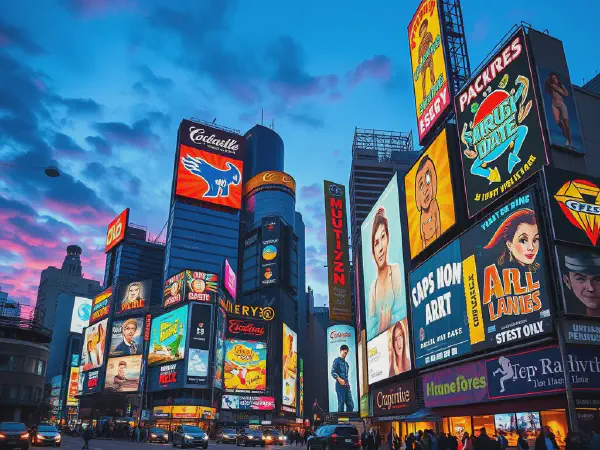Top Gigantic Signs That Captivate Attention Everywhere

Gigantic Signs: Giants of Visual Communication
Gigantic Signs play an integral role in capturing the attention of passersby and communicating messages on a grand scale. These enormous structures serve not only as advertisements but also as landmarks that reflect the identity and culture of their locations. Whether in vibrant urban centers or on desolate highways, Gigantic Signs command attention, making them a powerful tool in visual communication.
It’s not just their size that makes Gigantic Signs noteworthy; their design, creativity, and strategic placement also contribute to their effectiveness. From neon lights illuminating bustling streets to towering billboards visible for miles, these signs often embody the personality of a brand or place. In this article, we will explore the evolution, impact, and craftsmanship of Gigantic Signs, uncovering their significance in both advertising and culture.
The beauty of Gigantic Signs lies in their ability to evoke emotion and convey messages instantly. Through thoughtful design, brands can create visually stunning manifestations that complete urban landscapes and provide a unique experience for viewers. From the whimsical to the commercial, Gigantic Signs encompass a wide range of artistic expression and societal commentary, establishing a lasting connection between businesses and consumers.
Moreover, Gigantic Signs have transcended their original purpose of mere advertisement, evolving into cultural icons in their respective cities. They symbolize local pride, serve as navigational aids, and often become the backdrop for various events, ultimately bridging the gap between community and commerce. As we investigate the multifaceted world of Gigantic Signs, we’ll delve into their history, design innovation, and geographical significance.
Through this exploration, we aim to demonstrate how Gigantic Signs have become more than just visual tools; they are vibrant components of the storytelling fabric that defines urban landscapes.
History of Gigantic Signs
Gigantic Signs have evolved tremendously over the decades, with their origins dating back to the early 20th century. Initially, these signs were hand-painted advertisements designed to promote products or businesses in a manual and labor-intensive manner. The rise of neon lighting in the 1920s marked a significant turning point, leading to a new era of eye-catching illuminated signs that dazzled audiences. Over time, technological advances such as digital displays revolutionized the industry, enabling brands to convey dynamic and interactive messages.
Throughout history, certain Gigantic Signs have achieved legendary status, such as the iconic 'Hollywood Sign' in Los Angeles, which transcended its original purpose and became a symbol of the American film industry. Similarly, the 'Welcome to Fabulous Las Vegas' sign has become a cultural landmark representing the glitz and glamour of the city. These historical signs have not only impacted advertising but have also shaped tourism and local identity.
Culturally, Gigantic Signs symbolize more than commercialism; they often reflect societal values and aspirations. In many regions, these signs have become integral to the local identity, celebrating diversity and creativity. They grant urban spaces a sense of personality and serve as art pieces that foster community pride and showcase local heritage.
Impact on Advertising
Gigantic Signs significantly enhance brand visibility by drawing the gaze of pedestrians and motorists alike. Their sheer size and strategic placement make them difficult to ignore, ultimately elevating brand recognition. Advertisers strategically select locations for their gigantic signs in high-traffic areas to maximize exposure and ensure the messages reach the target audience effectively.
Notable brands, including Coca-Cola and McDonald's, have utilized Gigantic Signs to establish an unforgettable presence in competitive markets. Coca-Cola’s iconic giant mural in Times Square exemplifies how brands leverage immense signage to leave a lasting impression on consumers. This large format of advertising allows companies to create memorable experiences that resonate with diverse audiences.
When comparing traditional signs with digital versions, the difference is apparent not only in visual appeal but also in flexibility. Digital gigantic signs allow brands to change their messaging frequently while maintaining high visibility. This adaptability gives businesses the opportunity to engage consumers in real-time, demonstrating the shift from static to dynamic advertising landscapes.
Design and Creativity
Innovative designs play a crucial role in the effectiveness of Gigantic Signs. Designers often leverage artistic elements to create visually stunning structures that stand out. Employing creative typography, imaginative graphics, and unique materials, these signs can capture the essence of what they represent, intriguing the viewer to look closer and discover more.
Color and lighting are also paramount in the design of Gigantic Signs. Bright, bold colors grab attention, while clever use of lighting – such as LED technology – enhances visibility during nighttime, making these signs even more impactful. This combination of color psychology and illumination allows brands to communicate with emotions, setting the atmosphere necessary to attract target demographics.
Architecture is significant in the design of Gigantic Signs, as the surrounding environment needs to be considered to ensure that the sign complements its locale. Architects and designers often collaborate to create signs that harmonize with existing structures while still making a profound statement, showcasing not only the brand but also the artistry of design integration within urban settings.
Geographical Hotspots for Gigantic Signs
Certain geographical locations are renowned for their Gigantic Signs, with urban areas like New York City, Las Vegas, and Tokyo serving as hotbeds for these eye-catching installations. Iconic locations such as Times Square showcase a plethora of Gigantic Signs, drawing millions of visitors each year. These cities have embraced their signs, integrating them into the cultural fabric of urban life.
In contrast, rural areas often utilize gigantic signs as navigational aids, with large roadside billboards and messages that provide essential information for travelers. Although less frequent than their urban counterparts, these signs also play a vital role in capturing attention and supporting local businesses amidst expansive landscapes.
Cultural diversity is reflected in Gigantic Signs around the world. Different regions incorporate local languages, historical references, and traditional design elements into their signage, showcasing unique cultural narratives. From vibrant street art in Latin America to minimalist designs in Japan, Gigantic Signs become powerful symbols of identity that resonate with local populations and visitors alike.
Technology in Gigantic Signs
In modern times, technology has advanced the potential of Gigantic Signs significantly. Incorporation of video screens, interactive displays, and smart technology allows brands to engage audiences in new and innovative ways. The adaptability provided by these technologies enables real-time content updates, audience interaction, and enhanced visual experiences that were once unimaginable.
Interactive gigantic signs allow passersby to engage directly with the brand, fostering a sense of connection and involvement. These signs can facilitate social media interactions or provide instant feedback, enriching user experiences while simultaneously elevating brand engagement and loyalty.
Sustainability is becoming an essential consideration in the production of Gigantic Signs. Many companies are adopting eco-friendly practices, utilizing recycled materials, and implementing energy-efficient technologies to reduce the environmental impact of their signage. As consumers become increasingly aware of sustainability, brands investing in green signage solutions find opportunities to align with eco-conscious values and enhance their market presence.
